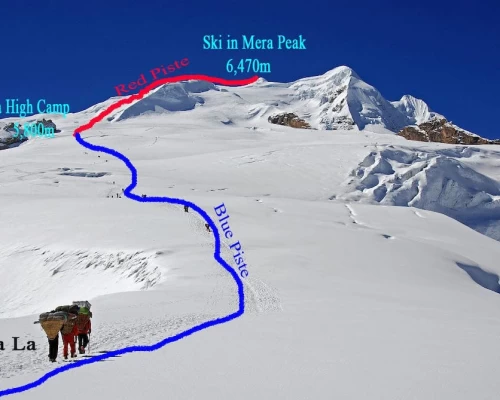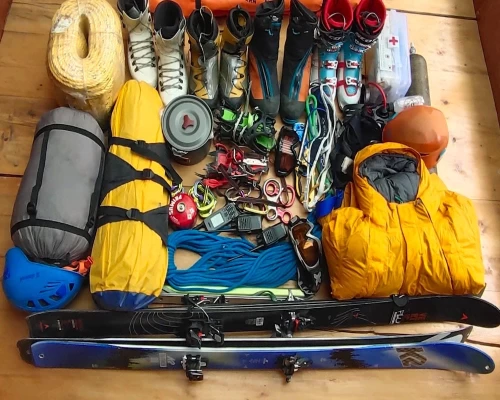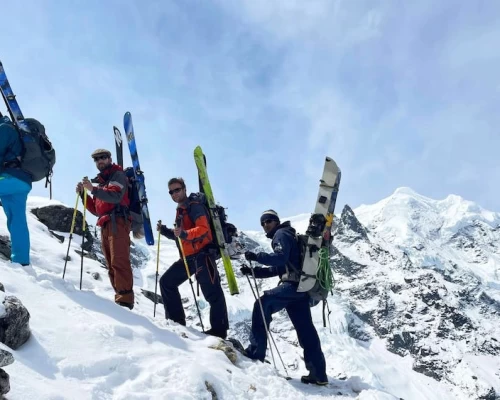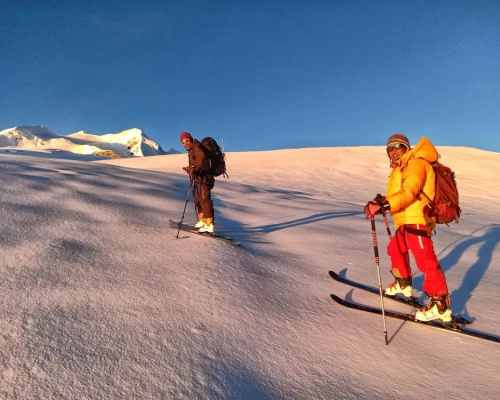Mera Peak Climbing and Ski Back Difficulty
Although not a technically demanding climb, the ascent of Mera Peak presents a formidable challenge. Because it is located at an extreme altitude of 6461m, despite its imposing height, the route to the top could be more complex compared to other trekking peaks in Nepal. Most of the climb entails traversing a glacier at a moderate incline using crampons and an ice axe. The only slightly more challenging section involves scaling a 5o degree snow dome with an ascender/jumar attached to a fixed rope.
Mera Peak, graded as Alpine Grade PD, is challenging due to technical aspects such as complicated glaciers and steep sections. This peak used to be considered easy, but glacier changes and technical climbs have increased its difficulty. Altitude is the primary challenge for climbers, with many succumbing to altitude-related illness at the summit's oxygen-deprived altitude of 6461m. Without supplementary oxygen, climbing Mera Peak becomes even more challenging. Climbers attempting any 6000m peak must be properly trained and prepared for the difficulties and hazards. A well-planned itinerary, proper acclimatization, contingency days, and training are necessary to mitigate risks. We recommend a long and careful approach to the mountain, avoiding a rapid gain in altitude by not restricting your itinerary. This approach will give your body more time to adapt to the increasing altitude.
There are various paths to reach Mera Peak from Lukla, but the most commonly used one is also the shortest. This route takes trekkers through the Zatrwa La pass at an altitude of 4600m. However, climbers have to face the challenge of high altitude. Many feel unwell and drained of energy when they arrive at Khare. Alternatively, a longer route passes through less-frequented villages like Pangoma, Chungbu Kharka, and Chalem Kharka, facilitating acclimatization. This longer itinerary has significantly increased the success rate of summiting Mera Peak. Although it takes an additional 2-3 days, it provides substantial benefits and improves the chances of reaching the summit.
The Summit Day and Ski Back From Mera Peak
Summiting Mera Peak marks the apex of the trek and is the ultimate test of one's physical and mental resilience. Standing at the summit is beyond words. You get to goggle upon the stunning scenic picture of the Himalayas. You can see the region's highest peaks and several other scattered peaks. The summit push commences very early in the morning, usually between 2-4 am, depending on the group's progress. The ascent from Mera High Camp to the Mera Summit is arduous, encompassing a total elevation gain of 661m. The time it takes to reach the summit varies depending on performance, with rest stops included, but typically takes 4-5 hours. As the sun rises, the summit comes into view, providing a morale boost to the climbers.
The early start to the summit push is imperative to ensure that climbers reach the summit in the morning and return to Khare by afternoon, avoiding the unpredictable and treacherous afternoon weather conditions. Typically, the morning weather is clear and pleasant, which makes it easier for climbers to traverse the glacier. However, afternoon weather conditions can be unpredictable and bring strong winds, making it challenging to descend safely. Climbing to the summit requires using essential climbing tools such as crampons, ice axes, and a man rope. The route to the summit rarely exceeds a 30-40 degree angle, making walking relatively easy. However, the final stretch involves a 30-meter ascent of a 50-degree snow dome, which requires climbers to use a jumar/ascender on a fixed rope, depending on the snow conditions. Summit day can be exhausting, lasting up to 10-12 hours.
The descent from the summit is equally challenging. Especially in the afternoon when the weather becomes unstable. Returning from Mera Peak to Base Camp is one of the trek's most exciting and adventurous experiences. Skiing back requires advanced skiing skills, including navigating rough terrain, steep slopes, and icy patches. Skiing back from Mera Peak to Base Camp requires adequate preparation, including appropriate gear, safety equipment, and experienced guides. The descent is abrupt, and the landscape can be difficult. So one must have the necessary skills and equipment to navigate safely. Avalanche safety gear, including transceivers, shovels, and probes, is essential for skiing back to Base Camp.
Altitude Sickness
In regions where mountains rise, the fear of altitude sickness looms. As altitude increases beyond 3500m, the likelihood of experiencing mountain sickness grows. The Mera Peak climb involves traversing from the lowest point of 1400m (Kathmandu) to the highest point of 6,476m (Mera Peak), with fluctuating altitudes in between. Therefore, individuals not accustomed to high altitudes may fall victim to Acute Mountain Sickness (AMS) or Altitude Sickness. This is one of the most challenging aspects of climbing Mera Peak.
Altitude sickness is a prevalent health issue during high-altitude treks and climbs above 3500m. As the elevation rises, your body responds to the decreasing oxygen level and increasing air pressure. Symptoms can range from mild, such as headaches and difficulty breathing, to severe, including fainting heart failure. It can also cause death if left untreated. At the summit of Mera Peak, the maximum altitude of 6,476m can cause a drop in oxygen levels from 88% to 43%, significantly increasing the probability of altitude sickness without proper precautions. Therefore, prior high-altitude trekking experience is beneficial, and adequate preparation is crucial. Staying hydrated at all times, acclimatizing and resting during the designated days, and taking altitude sickness medication like Diamox can help prevent the onset of AMS. It is also essential to remain aware of any physical changes and inform your climbing guide of any discomfort. Travelers with Insurance can get helicopter evacuation if their altitude sickness gets worse. But those with no Insurance backup can book helicopter service anywhere.
Proper acclimatization is a must for high-altitude climbing expeditions like the Mera Peak. The body needs sufficient time to rest and adjust to the environment before climbing even higher. Our team, with extensive climbing and guiding experience, has developed an itinerary based on scientific research and literature. You will have adequate time to acclimate.
Can I Climb Mera Peak and Ski Back?
Even without prior experience in peak climbing, novice trekkers can successfully climb Mera Peak as it is a non-technical ascent. However, the climb presents some difficulties as the trail passes through rugged paths with many ups and downs and mountain passes that test one's endurance. Upon reaching Khare, the trail to Mera Peak Base Camp and High Camp surpasses 5000m, where the oxygen level begins to deplete, adding another layer of challenge to the climb. The summit's final stretch also challenges, requiring 8 to 9 hours of ascent. Carrying heavy daypacks and equipment while wearing warm clothes only adds to the climb's difficulty. Therefore, individuals who are physically capable of walking on snowy, rugged trails for up to 6 hours a day, carrying backpacks weighing between 6 kg and 15kg, and acclimating to high altitudes are best suited for Mera Peak climbing.
According to a recent study, Mera Peak, standing tall at 6,476 meters above sea level in the Everest region, has been deemed suitable for ski mountaineering. The study was conducted by a team of two Nepali and two foreign mountaineers who climbed the peak and assessed its potential for skiing. Impressively, the foreigners skied down from the summit to the base camp in 30 minutes. In collaboration with Ski Guides, the Ski and Snowboarding Foundation Nepal conducted a study investigating the feasibility of ski mountaineering and ski training in the area. Utsav Pathak, President of the Ski and Snowboarding Foundation Nepal, confirmed that the study has proven Mera Peak to be an excellent location for skiing, making it accessible for all skiing enthusiasts to experience.
Which Weather is Perfect to Climb Mera Peak?
The allure of the grand Himalayan vistas from the summit of Mera Peak is undeniable, but harsh weather conditions can spoil this breathtaking experience. Wise climbers understand the importance of minimizing risks during their ascent and carefully select the optimal season for their journey. Failure to do so can result in forfeiting the chance to explore the ethereal realm of Mera Peak in the Khumbu region and confronting fierce winds and snowfall that amplify the already arduous climb. Therefore, prudent climbers should always aim to conquer Mera Peak during the most favorable season to avoid such challenges.
Climate In Mera Peak:-
As you launch on your Mera Peak climb, be prepared to encounter a range of climates. Starting from Kathmandu (1,300m/4265.092ft.) and reaching the peak at 6,476m/21246.72ft., you will witness a stark contrast in weather conditions. Understanding the climate zones of Mera Peak can help you determine the most suitable time for your climb. Throughout your journey, you will traverse four distinct climate zones.
The temperate climate at 1,200m-2,100m,
The frigid climate at 2,100m-3,300m,
The alpine climate at 3,300m-5,000m, and
Tundra climate above 5,000m.
Best Months:-
On-seasons are the opportune moments for Mera Peak Climbing, providing the perfect conditions for diving straight in without apprehension. These prime periods, commonly called the best or peak times, offer a harmonious combination of factors: stable weather patterns, comfortable temperatures, absence of precipitation, and minimal unexpected changes. Autumn and Spring are the two exceptional timeframes embodying all these elements. Delving deeper into each season will reveal their unique characteristics.
Autumn Season:- When climbing Mera Peak, there's no better time than Autumn to experience Nepal's safest, most thrilling, and visually stunning season for adventurous activities. Autumn arrives in Nepal in September, October, and November, with September being the season's first month. There may be some lingering monsoon clouds in early September, Autumn stabilizes the entire region from mid-September onwards. It brings warmer temperatures and no more rainfall or snowfall.
Throughout October and November, the lower Khumbu region enjoys daytime temperatures around 12°C and morning and evening temperatures ranging from 6 to 8°C, with temperatures dropping below freezing in higher elevations close to Mera Peak. Winter follows Autumn, so the last few days of November may be colder than the rest of the season. If you plan on climbing in November, pack extra warm clothing to cope with the upcoming Winter. Similarly, light rain is expected in early September, so be prepared with rain gear or schedule your expedition for mid-September, October, or early November.
Spring Season:- When climbing Mera Peak, Spring is just as good as Autumn. The conditions during Spring are similar to those during Autumn, with stable weather and warm temperatures that are suitable for climbing. In addition, Spring brings with its lush greenery and blooming flowers, providing a beautiful view while climbing. This season lasts from March to May in Nepal.
You can enjoy several benefits if you plan to climb Mera Peak during Spring. The temperature in the lower Khumbu region remains around 10°C during the day. Likewise, it drops to as low as -4°C in the mornings and nights. The temperature drops further, reaching as low as -30°C at the peak while climbing. However, with proper gear and clothing, the temperature is bearable.
Another advantage of climbing Mera Peak in Spring is the stable weather. There is no worry of rainfall or snowfall, and the days are bright. These months have clear skies and sunshine, making climbing easier. You can also enjoy breathtaking views of mountains and terrains, including Mt. Everest, Mt. Lhotse, and Mt. Cho Oyu, which look different during Spring.
However, remember that the first few weeks of March can be colder due to the remaining winter season, so warm clothing is necessary. Likewise, rain clouds maybe during late May as the monsoon season approaches Nepal. To avoid such weather conditions, it is best to plan your climb in April, which is the best month of Spring.
Off Seasons:-
Mera Peak Climbing attracts many adventure seekers all year round. But the off-seasons challenge climbers differently. Harsh weather conditions characterize these periods. Rainfall, snowfall, cold temperatures, and others make it challenging to climb the peak. The off-seasons are typically summer and winter. They have unique features requiring different preparations and strategies.
During summer or monsoon, the peak experiences heavy rainfall that fills the trails with mud and snow in the higher parts. There are better times for climbing than this, but some daring climbers have tried their luck during this period. The temperature before the rainfall is relatively warm, with trekking trails around 15°C in the daytime. However, temperatures increase as you climb higher. However, once the rains start, temperatures drop significantly. This makes the climb even more challenging for climbers. One good thing about climbing Mera Peak during the monsoon is that mountain views are crystal clear after the rain, providing a spectacular experience for climbers. Climbing during this period is risky, but late August or early June could be the best time to try your luck.
Winter is another off-season for Mera Peak Climbing. This is the driest and coldest of the year, which keeps most people under warm blankets. The temperature drops significantly during December, January, and February, and snowfall in the higher parts is common. The peak winter month, January, is the coldest, with temperatures dropping to -20°C and bone-chilling -30°C in higher parts. The advantage of climbing during winter is that there is no rainfall, making the trails less slippery, and the mountain views are easily visible. Early December and late February offer milder temperatures, making climbing more manageable.
Cost of Mera Peak Climbing and Ski Back Expedition
For just $2500 per person, the Nepali Travel agency offers an exceptional opportunity to climb Mera Peak and ski back to Mera Base Camp. By booking with a local Nepal trekking agency such as Mountain Rock Treks, you can keep a significant portion of your money within Nepal. This is a cost-effective and convenient option for many.
When booking through a local Nepali trekking agency, you have two choices: hiring a local guide or purchasing a tour package. The latter option includes everything you need for the trek. This includes permits, accommodation, and domestic transport. The cost of a package trek for an average 17-day trek can range from $2500- $30000 or more. It depends on the type of package you choose. Although travel drinking water, travel insurance, trekking equipment, and visa fees are not included in the prices. Your accommodation, trekking permits, meals, and local transportation are covered. Different packages are available, ranging from high-end tours to mid-range options to packages. While the trekking routes are the same in all packages, the provided meals and accommodations may differ.
Accommodations:-
In Kathmandu, there are countless options for accommodation. The accommodations range from basic lodges to luxurious 5-star hotels, priced at $15 to $250 per night. Your choice of accommodation will ultimately determine the cost.
However, as you trek from Lukla to Khare, your options for accommodation are limited to tea houses, which offer shared rooms with two beds or dorm rooms. The cost of these rooms ranges between $10-$30. However, the costs also depend on your negotiation skills, group size, and the season. The accommodation cost will be slightly higher if you opt for a luxury trek to Mera Peak. Your room will have basic facilities such as a bed, clean mattress, sheets, and blanket.
At Mera Base Camp, you must camp for the night and continue your trek towards Mera High Camp the next day. Once again, you must camp at Mera High Camp before climbing Mera Peak at dawn. You can either rent or buy a tent suitable for the trek. A durable and suitable tent costs from $150 to $300. The tent's cost varies with brand, quality, durability, and the number of people it accommodates.
Foods:-
Kathmandu offers many options for meals and drinks, similar to accommodation. The cost of your meals and drinks in Kathmandu depends on your preferences, as the choices are endless. You can enjoy a vital meal ranging from $2 to $50. While on the trails from Lukla to Khare, your options for meals and drinks are slightly limited but still moderate. Most tea houses, restaurants, and cafes on the trails have a primary menu. The menu includes dal-bhat-tarkari, roti, noodles, fried rice, momos, and more. You can expect to pay $5-$30 per plate for these options. Additionally, a cafe in Namche Bazaar offers delicious fresh bread and pastries.
You can choose varieties like tea, coffee, hot and cold flavored drinks, soups, soft drinks, and hot and cold water. These beverages can vary from $5 to $20 per glass or cup. However, as you go from Khare to Mera Base Camp and back, your meal and drink options are limited to what the porters carry. Our cook will prepare and serve hygienic food for you. So you can still enjoy a satisfying and nourishing meal.
Guide and Porters
Expedition to Mera Peak is an awe-inspiring and challenging experience that takes you off the beaten path. To ensure your safe and successful summit, it's essential to have the right support team in place. Here are the field staff you'll need for your journey.
You will first need a knowledgeable and experienced guide to accompany you on your trek. Mera Peak's trails are unmarked and unpredictable, so a guide can provide critical insight into the terrain and keep you safe. They can also offer valuable information about the surrounding peaks, landscapes, flora, and fauna. Their help will enhance your trekking experience. The cost for a guide on your Mera Peak climb is typically around $25-$35 per day. You'll also want an experienced climbing guide if you plan to climb the peak. A climbing guide is highly skilled in summiting mountain peaks and can assist with the technical aspects of your climb. They may also offer basic mountaineering training to help you tackle the peak's challenges. A climbing guide typically costs $325-$400 per peak.
An assistant guide is another valuable asset, especially for larger groups. Though they may have less experience than a fully licensed guide, an assistant guide can help improve your trekking expertise. They will assess the main guide and set up camp. They can also help tend to the individual requirements of each group member. The cost for an assistant guide ranges from $18 to $30 per day. Lastly, porters are essential for lightening your load and making your trek more comfortable. Depending on your group size, you may need multiple porters too. They will help you carry your equipment and supplies you won't need on any particular day. Each porter can carry up to 25 kg of weight while you carry your day backpack containing your necessary items. The cost for a porter is typically $15 per day. With the right team in place, you can summit Mera Peak and ski back comfortably and successfully, all while enjoying the breathtaking beauty of the Himalayas.
Gears and Equipment Needed:-
When planning for a trek up Mera Peak, it's essential to consider the gear and equipment you'll need to bring with you. The cost of this equipment can vary depending on whether you choose to rent or purchase it and the brand and quality of the product. You'll need the standard equipment and supplies required for any trek, such as a backpack, sleeping bag, and appropriate clothing. In addition, you'll need specific gear for climbing Mera Peak.
A climbing harness will cost around $50-$60, while 5 meters or more of a 6mm climber's accessory cord will cost $5-$10 per meter. A Figure 8 or Abseil belay device will cost between $8-$36, and a large mitten-sized ascender (such as the Petzl) and arm-length leash will cost $25-$70. Moreover, you'll also need 2 locking carabiners (1 large and 1 small) for $8-$12 each and 4 regular carabiners, which will cost the same. An ice axe with a leash is necessary and can cost between $80-$150. Crampons are also required, and it's important to get steel crampons with anti-balling (anti-bot) plates for safety. These will cost between $8-$15. Adjustable trekking poles are recommended and can cost between $20-$60.
Safety equipment is also important, and a helmet is necessary, costing between $40-$200. Ski goggles will cost around $80-$150, and glacier sunglasses with side shields will cost $50-$65. An oximeter is also recommended for monitoring oxygen levels, costing between $14-$22. Remember that rental costs can range from $1-$10 per item daily if you rent it instead of purchasing it. You can ask for bulk discounts and negotiate prices while renting in Thamel.
Moreover, before renting or buying, ensure the authenticity and quality of the equipment. You can easily purchase or rent gear in Kathmandu and Lukla. Generally, prices are lower in Kathmandu.
Travel Insurance and Helicopter Evacuations:-
It is highly advisable to have travel insurance that covers treks and high-altitude climbs such as Mera Peak Climbing. This is crucial for your safety and is often a requirement for reputable trekking agencies. The cost of good travel insurance for Mera Peak Climbing can range from $125-$280, depending on the provider and coverage. As a general rule, travel insurance costs typically 4%-10% of your total, non-refundable travel cost. For an average Mera Peak Climbing expedition, which costs around $2500, your travel insurance would cost around $250.
If you already have travel insurance, confirming that it covers high-altitude climbs and emergency helicopter evacuations in countries such as Nepal is important. Additionally, it is recommended to get travel insurance from your home country.
During the Mera Peak climb, climbers may encounter acute mountain sickness (AMS) and High Altitude Cerebral Edema (HACE). These conditions can increase the difficulty level of the expedition. In some cases, climbers may require emergency evacuation via helicopter. Without proper insurance coverage, the cost of emergency evacuation can be astronomical.
Fortunately, helicopter service from Mera Peak is available for those requiring emergency returns. The service is just a call away, and the staff provides quick assistance and aid to the patient. Helicopter service is not as exact as helicopter evacuation. But it is an excellent option for those traveling and wanting to return to Kathmandu within budget and a short time.
Permits
NMA Mera Peak climbing permit:- To climb to Mera Peak, you need to pay a fee for the NMA Mera Peak Climbing Permit, which varies depending on the popularity of the trek and the season. During spring, with clear skies and favorable climbing temperatures, the permit costs USD250. Autumn is also a peak season for Mera Peak Climbing, with a permit cost of USD125. Conversely, the winter and summer seasons are considered off-season, resulting in a lower cost for the permit. You can obtain the NMA Mera Peak Climbing Permit during these seasons for only USD70.
Local Area Permit:- Obtaining a local area permit is necessary to enter the region for climbing. You can acquire this permit upon arrival in Lukla. However, in many cases, the travel company you are associated with may arrange for the permit beforehand. The cost of the Local Area Permit is approximately USD 20 or NRs. 2000.
Makalu Barun National Park Entry Permit:- Climbing Mera Peak requires an additional permit. Once you arrive at the National Park, you will have the opportunity to observe various unique species. Since the park is part of the Makalu Barun National Park, you must obtain a Makalu Barun National Park Entry Permit to view them. The permit fee varies depending on your nationality:
Locals: No fee
SAARC Nationals: NPR 1500 (plus NPR 165 VAT charge)
Foreign Nationals: NPR 3000 (plus NPR 390 VAT charge)









